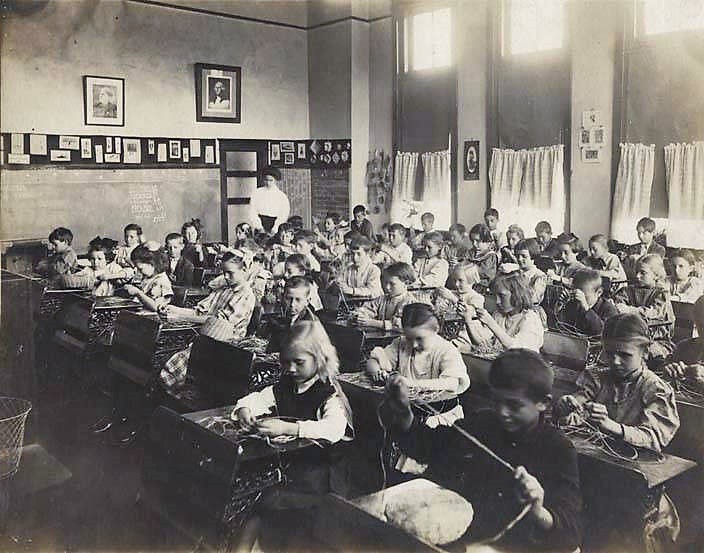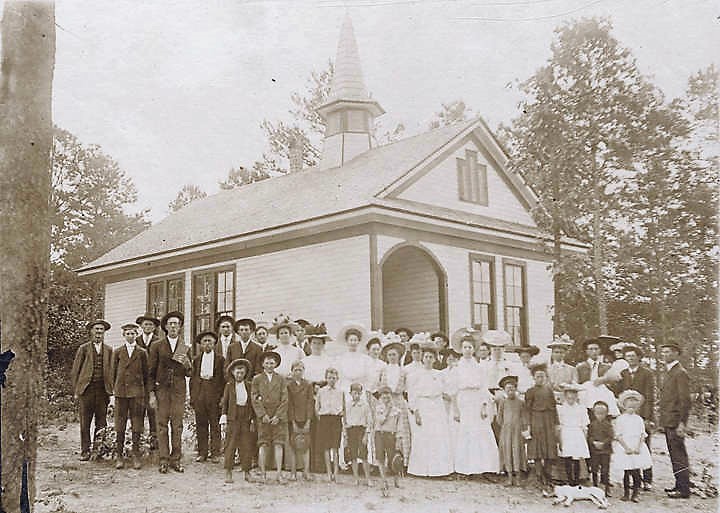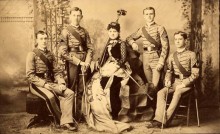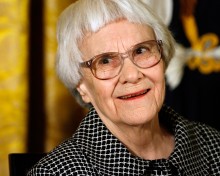(Continued from Part III – The author Gen. William F. Perry was the first superintendent of education in Alabama)
THE GENESIS OF PUBLIC EDUCATION IN ALABAMA.
By
Gen. William F. Perry,1 of Bowling Green, Ky.
Written 1898
(Transcription from Transactions of the Alabama Historical Society, Volume 2, 1898)
Part IV
MOVEMENT
The first of January, 1855, was fixed as the beginning of the school year; and the rude machinery began to move, slowly here, with jar and friction there, but it moved!
The year 1855 was spent in visiting the counties of the State, and in conducting an extremely heavy correspondence. Questions of all shapes and sizes, growing out of every thinkable complication of conditions, came in a continuous stream. At first, some of them were very embarrassing. After a time, however, I became so saturated with the system, in its entirety and in its details, that my mind reached conclusions with ease and confidence. Of course, I made it understood that my opinions carried with them no judicial authority; but it is, even now, a source of pleasure to remember that no case ever came to my knowledge in which the parties in controversy failed to acquiesce in my decisions ; and that I was able in numerous instances, to harmonize dissensions and prevent litigation.
In my tour through the State, I found the schools generally in operation and the people pleased and hopeful, especially in those countries which were most benefited by the system; and returned to my office feeling fully assured that the public educational system of Alabama, though still crude and imperfect, had come to stay.
It was a source of much regret, that the statistics, which I was able to collect, of the first year’s work of the schools, were not such as could be set forth in tabulated form in my report to the legislature, which met in December, 1855. I, therefore, gave only a brief history of what had been done, and discussed some changes in the school law which were imperatively demanded.
I was very apprehensive that the tardiness with which the machinery had moved off, and the fact that I was unable to make a complete report, would furnish a pretext to the enemies of the system to make an assault either upon it, or upon my administration; but was gratified to find no open manifestation of hostility.
RECONSTRUCTION
The Committees on Education of the Senate and House of Representatives, 1855-56, were gentlemen of broad views, in thorough sympathy with the purposes of the system. The Hon. R. M. Patton, of Lauderdale, and Col. Thomas H. Hobbs, of Limestone, were the Chairmen. The Committees met in joint session, and requested my presence at every meeting. The utmost harmony prevailed, and there was everywhere visible an earnest desire to do the best possible for the interests of public education in the State.
Children and adults standing outside the school building in district 34 of Cleburne County ca. 1900 (Alabama Department of Archives and History)
The school law was entirely remodeled and greatly simplified and improved.10 The creation of the office of County Superintendent was a change of vital importance, and would of itself have marked an epoch in the history of the system.
The appropriation was so increased as to raise the pro-rata to one dollar and fifty cents. The methods of disbursement were also greatly simplified. The amounts declared to be due the various counties, by the State Superintendent, were required to be deposited in the county treasuries to be subject to the drafts of the County Superintendents; and all officers were held to strict account for money coming into their hands.
Having been re-elected without opposition, and now assured of efficient County administration, I entered upon my second term of office with renewed confidence and energy. The revised school law with notes and explanations were published in connection with a complete book of forms and instructions for all transactions connected with the public schools.
The methods previously recommended for the employment of teachers, and for the disbursement of the public money were continued; and minute directions for the distribution of the money in payment of tuition were given to the teachers, illustrated by an actual example of a settlement made upon assumed data. I was still haunted by the dread of a miserable little system of free public schools supported with inadequate means.
To systematize and facilitate the work of the County Superintendents, an account book was prepared, which, by various rulings and captions in different parts, was adapted to every possible record connected with their office. It was so arranged and spaced, that if properly kept, it would contain a complete history, statistical and financial, of the county schools running through a series of years.
It was with a feeling of inexpressible relief that I saw the great bundles of instructions carted to the post office to be sent to their destination. It was such as a mariner might experience who had been long bound in shallows and quicksands, when he first spreads his sails on an open sea beneath a clear sky.
RESULTS
I felt confident that new life and vigor would be imparted to the system; and the results fully equalled my expectations. The County Superintendents entered upon their duties with energy and enthusiasm. Dead locks were at an end, and jar and friction were fast disappearing. Many new schools were established, and more attention was given to the comfort and convenience of schoolhouses, though much still remained to be done in that direction. Increased interest and larger compensation had a marked tendency to bring into the schools teachers of better qualifications.
At the end of the year, full reports were received from all the counties showing most gratifying results of the year’s work.
I regret that I am not able to give specific facts and figures from my report for the year 1856; but remember that I was very proud of the exhibit which I was enabled to make.
The report for 1857 showed still farther progress on all lines. There was a decided increase in the number of children reported by the trustees, and in the number both of schools and of pupils in attendance. My recollection is, that the number of pupils attending the schools was about one hundred thousand, and there was evidence to believe that the people, stimulated by the aid extended by the State, had expended far more on their schools than they had ever done before.
It will doubtless be observed that the law contained no requirements, either as to the character of the school houses used, or as to the qualifications of the teachers employed. Some would doubtless urge this as a fatal defect of the system; but it was the result of deliberate design. So much was to be done, that it was thought best to attempt but one thing at a time; to begin at the bottom and build up, rather than make a vain attempt to begin at the top and build down. If even moderate requirements had been made and strictly enforced, either as to the qualifications of teachers, or as to the character of the buildings which they were to occupy, more than half the schools would have disbanded, and the system would have collapsed. The demand of the hour was visible results in the shape of schools; and it was the part of wisdom to bend every energy to perfect the external machinery by which that demand could be met.
Third-grade students working with raffia at their desks at Minor School in Birmingham, Alabama ca. 1900-06 (Alabama Department of Archives and History)
But this had now been done. The external machinery of the system was working without friction. A trial of two years had disclosed no feature that needed material modification. In the legislative session of 1857-8, no amendment was adopted, or even suggested.
But all this was only the first step toward the great end to be attained. There is no need to say that that end was the creation for the youth of this State such an environment, material, mental and moral, as would conduce to their development into health, intelligence and usefulness.
The extent to which all that had been done fell short of this high ideal was depressingly suggestive of the magnitude of the task still to be accomplished.
In one of my reports I discussed at length, and in as strong terms as I knew how to employ, the cruel discomforts to which the children of the State were subjected, and the cruel injustice they suffered in being put under the care of incompetent teachers.
I fully intended, as long as my connection with the system continued, to employ every instrumentality in my power to improve these deplorable conditions, and to lift the system to a higher plane of efficiency and usefulness. But that connection ‘was unexpectedly severed in the middle of my third term of office. The shadows of a great war were gathering; its desolations soon followed; and then came the chaos of reconstruction.
BIBLIOGRAPHICAL NOTE
By The Editor,
The school system of the State, although the subject of almost continuous discussion since its adoption, has received meagre historical treatment. This paper is perhaps the fullest account of the origin and organization of the effort. The most extensive general treatment is contained in Willis G. Clark’s History of Education in Alabama (1889). in the Chapters: “Educational Land Grants,” pp. 217-219; “The Public School System of Mobile,” pp. 220-239; and “Public Schools in Alabama,” pp. 239-253. These chapters are in the main correct, although there are some blunders and glaring omissions.
The “School Law of Alabama” is reviewed anonymously in Ala. Ed. Jour., Dec, 1858, and April. 1859; and Ala. Jour, of Education. April. 1871, contains an article on “Alabama Public Schools before the War.”
In Barnard’s American Journal of Education, and in the Reports of the U. S. Com. of Education, there are numerous references passim.
Mr. Clark finds the origin of the present State system in the Mobile public school system which had its beginning in 1826. A full review of all the legislation in relation to th. latter from Jan. 10. 1826, is presented by Peter Hamilton, Esq., in his Brief for appellee in the cases of the State of Alabama, ex. rel. G. L. Putnam vs. Gustavus Horton, Judge of Probate: the same vs. E. B. Lott. Tax Collector: and W. G. Clark, et. als. vs. E. P. Gaines, et. als. in Supreme Court of Alabama, June term, 1870, (8vo, pp. 23).
The source material is extensive, and is contained in the Reports of the Superintendents of Education, the Journals of the Board of Education, the School Laws (separately printed), and Miscellaneous Legislative and Official documents. Full and classified lists of these are presented, under the title of “Schools,” in Owen’s “Bibliography of Alabama,” in Report of American Historical Association for /S07, pp. 1131-1136.
The Auditor’s Reports contain financial statistics.
Statistics of the Sixteenth Section funds are found in the several Legislative reports, and in the Auditor’s Reports.
For further bibliographical references sec Owen’s Bibliography of Alabama under the titles—Agricultural and Mechanical College, Educational Association, et seq. Schools, University of Alabama, and the names of particular educational institutions, schools, or colleges.
1 William F. Perry, son of Hiram and Nancy (Flake) Perry, was born in Jackson County, Ga., 1821. He was largely self-taught; and was in charge of a high school in Talladega, 1848 to 1853. He was admitted to the bar in 1854, and in February of the same year was chosen Superintendent of Education. This position he resigned in 1858, and returned to the school room as head of the East Alabama College at Tuskegee. In 1862 he enlisted in the Confederate Army, and became Major of the 44th Alabama. (See sketch of this Regiment by J. J. Garrett infra.) He became successively Lieutenant Colonel, Colonel and Brigadier General. He was a brave and fearless soldier, and splendid official and executive. In 1867 he removed to Ky., where he has since resided, engaged in teaching. He married a daughter of George P. Brown, whose wife was a daughter of Thomas Chilton, Esq. For sketch see Garrett’s Public Men in Ala., p. 595; and Brewer’s Alabama, p. 343-4. The latter gives his military record.
Mr. Perry had preserved all important papers accumulated during his term of his office, but unfortunately they were destroyed during the Civil War. Hence, residing in a distant State, he was compelled to rely almost entirely upon memory in the preparation of this paper.
ALABAMA FOOTPRINTS Exploration
Some stories include:
- The true story of the first Mardi Gras in America and where it took place
- The Mississippi Bubble Burst – how it affected the settlers
- Did you know that many people devoted to the Crown settled in Alabama –
- Sophia McGillivray- what she did when she was nine months pregnant
- Alabama had its first Interstate in the early days of settlement






